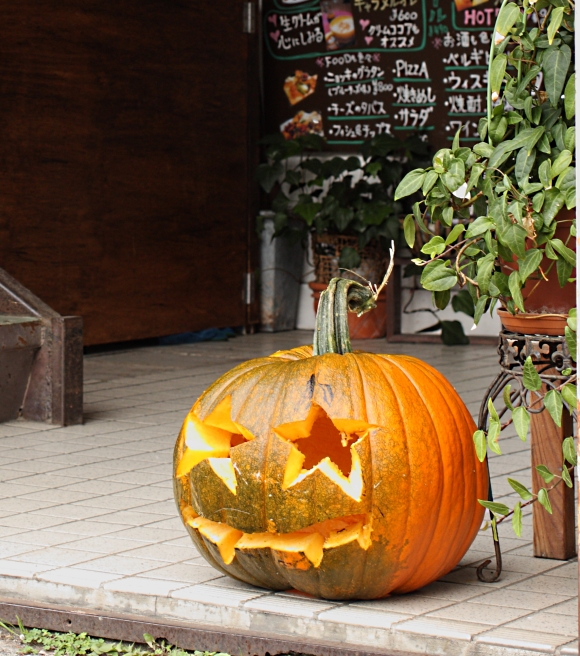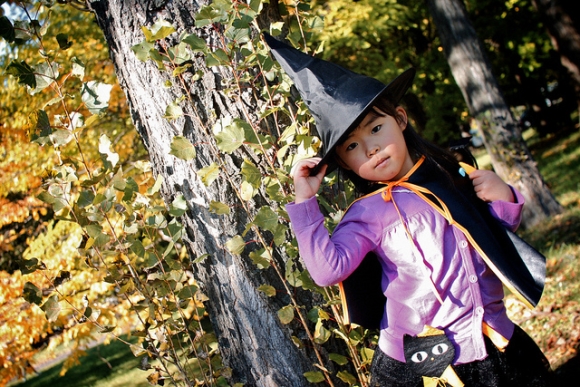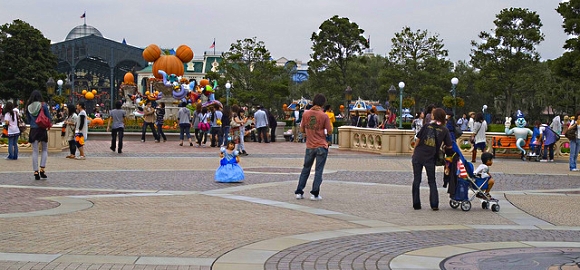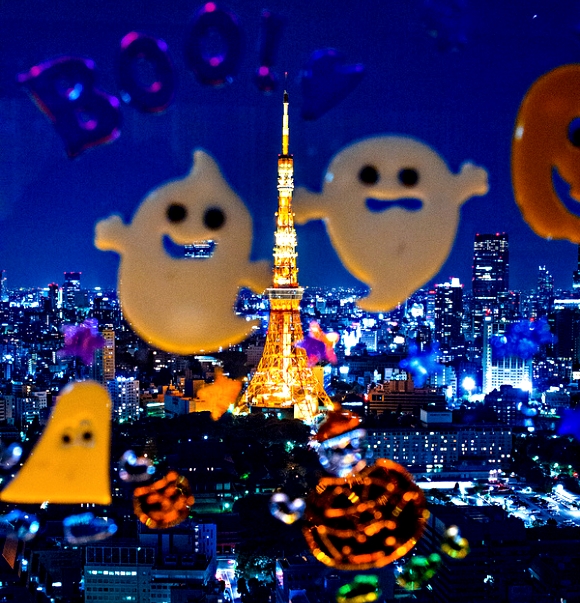
Just like in many Western countries right now, in Japan ’tis the season to be spooky. Halls in Tokyo are decked with orange; cute pumpkins, witches and ghosts wink from shop windows; and you might even find a special seasonal pastry in your local bakery or supermarket.
Now firmly established in the annual Japanese calendar, not so long ago hardly anyone even knew that such a thing as Halloween existed. How could this day, which has become more like a month-long festival in Japan, go from zero to hero so quickly? What brought this on, and why is it so big in Japan? Japan’s Madame Riri looks at four different reasons.
▼ Distinctive pumpkin Mickeys pump up Halloween’s public profile
Image by Masashi Yanagiya
1. Theme parks introduce “Happy Halloween”
Up until about the year 2000, Halloween was something people would only hear of by learning English or watching TV programs from other countries. But when Tokyo Disneyland got in on the act (let’s face it – there’s money to be had from a simple spooky makeover), people began to sit up and take notice. On 31 October 1997, visitors to Disneyland wore costumes to be part of “Disney Happy Halloween”. Then in 2000, 400 visitors and Disney characters in costume held a “Happy Halloween Twilight Parade” in the park.
Already enamored of Disneyland, the people of Japan were enchanted by this new idea of Halloween. The event was a hit in 1997, and the scale of the party increased along with public awareness, until Halloween became established as an annual autumn event. Currently the lavish celebration kicks off sometime in early September.
Universal Studios Japan opened its doors in 2001, and got in on the act from 2002 with “Hollywood Halloween”. The two major theme parks of Japan gradually brought Halloween more and more into the public consciousness.
2. Cosplay culture

Image via Samurai Dave
A big part of Halloween’s popularity could be attributed to “fancy dress”. I mean, how many other events do you get to dress up for? And dress up to look hot. Reindeer sweater or jingle bell earrings? Not so sexy. Vampire or werewolf? Reowww!
Plus, Japan is the homeland of cosplay, where many love to transform themselves into their favourite anime or video game characters. Japanese fashion also tends to be less conservative. Walk down Takeshita street in Harajuku anytime, and you’ll spot out-there outfits. Even before Halloween landed in Japan, the Takenoko-zoku were dancing it up on the street in attention-grabbing wear, and the yankii were bleaching and teasing up a storm to create their distinctive punk looks.
With such a distinguished history of fancy dress, the quick adoption of Halloween costume parties isn’t too much of a surprise. If only Easter or Thanksgiving had such great costumes, they might also be as well known by now!
3. Children learning English

Image by Yoshihito Miki
Some people in Japan probably first heard of the foreign concept of decorating pumpkins when they were children during their English classes. But when they came home, primed to attack pumpkins with carving knives, their families would have been confused, not having heard of any such event.
Time has flown by since then. The world is growing increasingly global, and Japan places a high importance on English language proficiency. In 2011, English became a compulsory subject for Year 5 and 6 primary school students. In addition, major companies such as Uniqlo and Rakuten have lately adopted English as their official language for all operations. The movement to proactively learn English gained momentum.
In this climate, children’s English education came to the fore. The number of parents taking their children to English conversation lessons soared, and as the kids picked up more English conversation, the idea of Halloween spread. For young learners, it’s not just about memorizing lists of verbs—the majority of schools aim to make learning fun by incorporating elements of foreign culture. So don’t be too surprised if you hear a knock on the door of your manshon (high-end apartment) and a high-picthed chorus of “Trick or treat!”
4. Japanese national character
Image by Takuma Kimura
Halloween in Japan is a little different to the Halloween of other countries. Halloween was originally a celebration of the autumn harvest and a ritual to appease spirits of the dead–the Japanese equivalent would be the Bon Festival. But not many Japanese people know that Halloween was said to be the day on which the spirits of the dead visit their family homes. To be honest, I didn’t really know that myself, and I’m not planning on leaving food out for them, except candy. Sorry, ancestors!
Basically, Japanese Halloween is a fun celebration, purely for amusement value and without cultural subtext. It’s highly commercialized, just as Christmas is.
Japan has a tendency to adopt festivities from other cultures, like Valentine’s Day, Christmas, and even Beaujolais Nouveau, which may be related to the insatiable passion Japanese consumers have for new and interesting seasonal flavors—just look at all the different varieties of KitKat!
Accustomed to honoring the four seasons, most businesses use seasonal celebrations as part of their marketing strategy. Events which may have begun as a commercial exercise may take on a wider social meaning (like Valentine’s Day). The popularity of Halloween in recent years may be directly tied to this consumer affection for seasonal celebrations.
Either way, I can’t resist a pumpkin choux creme. Hello, Halloween!
Source: Madame Riri
Featured image by iyoupapa



 Japan starts getting ready for Halloween…in August?!?
Japan starts getting ready for Halloween…in August?!? Halloween is the perfect time to pick up Japanese women, according to new survey
Halloween is the perfect time to pick up Japanese women, according to new survey USJ unveils its Halloween lineup, including some first-ever Pokémon food and fun collaborations
USJ unveils its Halloween lineup, including some first-ever Pokémon food and fun collaborations Shibuya City cracks down on Halloween 2023 with massive “Stay Away!” campaign
Shibuya City cracks down on Halloween 2023 with massive “Stay Away!” campaign Starbucks Japan’s newest treats: the Purple Halloween Frappuccino and a gruesome-looking dessert
Starbucks Japan’s newest treats: the Purple Halloween Frappuccino and a gruesome-looking dessert McDonald’s new Happy Meals offer up cute and practical Sanrio lifestyle goods
McDonald’s new Happy Meals offer up cute and practical Sanrio lifestyle goods All-you-can-drink Starbucks and amazing views part of Tokyo’s new 170 meter-high sky lounge
All-you-can-drink Starbucks and amazing views part of Tokyo’s new 170 meter-high sky lounge Studio Ghibli glasses cases let anime characters keep an eye on your spectacles
Studio Ghibli glasses cases let anime characters keep an eye on your spectacles Starbucks reopens at Shibuya Scramble Crossing with new look and design concept
Starbucks reopens at Shibuya Scramble Crossing with new look and design concept Hamster abandoned at Tokyo ramen restaurant gets new home
Hamster abandoned at Tokyo ramen restaurant gets new home Beautiful Sailor Moon manhole cover coasters being given out for free by Tokyo tourist center
Beautiful Sailor Moon manhole cover coasters being given out for free by Tokyo tourist center Mister Donut ready to make hojicha dreams come true in latest collab with Kyoto tea merchant
Mister Donut ready to make hojicha dreams come true in latest collab with Kyoto tea merchant Kyoto’s 100 Demons yokai monster parade returns!
Kyoto’s 100 Demons yokai monster parade returns! More foreign tourists than ever before in history visited Japan last month
More foreign tourists than ever before in history visited Japan last month Hey, Japanese taxi driver! Take us to your favorite restaurant in Tsuruga City!
Hey, Japanese taxi driver! Take us to your favorite restaurant in Tsuruga City! Disney princesses get official manga makeovers for Manga Princess Cafe opening in Tokyo
Disney princesses get official manga makeovers for Manga Princess Cafe opening in Tokyo Beautiful new Final Fantasy T-shirt collection on the way from Uniqlo【Photos】
Beautiful new Final Fantasy T-shirt collection on the way from Uniqlo【Photos】 Is the new Shinkansen Train Desk ticket worth it?
Is the new Shinkansen Train Desk ticket worth it? Foreign English teachers in Japan pick their favorite Japanese-language phrases【Survey】
Foreign English teachers in Japan pick their favorite Japanese-language phrases【Survey】 Japanese convenience store packs a whole bento into an onigiri rice ball
Japanese convenience store packs a whole bento into an onigiri rice ball We try out “Chan Ramen”, an underground type of ramen popular in the ramen community
We try out “Chan Ramen”, an underground type of ramen popular in the ramen community Studio Ghibli releases Kiki’s Delivery Service chocolate cake pouches in Japan
Studio Ghibli releases Kiki’s Delivery Service chocolate cake pouches in Japan Japan’s bone-breaking and record-breaking roller coaster is permanently shutting down
Japan’s bone-breaking and record-breaking roller coaster is permanently shutting down New definition of “Japanese whiskey” goes into effect to prevent fakes from fooling overseas buyers
New definition of “Japanese whiskey” goes into effect to prevent fakes from fooling overseas buyers Our Japanese reporter visits Costco in the U.S., finds super American and very Japanese things
Our Japanese reporter visits Costco in the U.S., finds super American and very Japanese things Studio Ghibli unveils Mother’s Day gift set that captures the love in My Neighbour Totoro
Studio Ghibli unveils Mother’s Day gift set that captures the love in My Neighbour Totoro Foreign passenger shoves conductor on one of the last full runs for Japan’s Thunderbird train
Foreign passenger shoves conductor on one of the last full runs for Japan’s Thunderbird train Domino’s Japan now sells…pizza ears?
Domino’s Japan now sells…pizza ears? New Japanese KitKat flavour stars Sanrio characters, including Hello Kitty
New Japanese KitKat flavour stars Sanrio characters, including Hello Kitty Kyoto creates new for-tourist buses to address overtourism with higher prices, faster rides
Kyoto creates new for-tourist buses to address overtourism with higher prices, faster rides Sales of Japan’s most convenient train ticket/shopping payment cards suspended indefinitely
Sales of Japan’s most convenient train ticket/shopping payment cards suspended indefinitely Sold-out Studio Ghibli desktop humidifiers are back so Totoro can help you through the dry season
Sold-out Studio Ghibli desktop humidifiers are back so Totoro can help you through the dry season Japanese government to make first change to romanization spelling rules since the 1950s
Japanese government to make first change to romanization spelling rules since the 1950s Ghibli founders Toshio Suzuki and Hayao Miyazaki contribute to Japanese whisky Totoro label design
Ghibli founders Toshio Suzuki and Hayao Miyazaki contribute to Japanese whisky Totoro label design Doraemon found buried at sea as scene from 1993 anime becomes real life【Photos】
Doraemon found buried at sea as scene from 1993 anime becomes real life【Photos】 Tokyo’s most famous Starbucks is closed
Tokyo’s most famous Starbucks is closed One Piece characters’ nationalities revealed, but fans have mixed opinions
One Piece characters’ nationalities revealed, but fans have mixed opinions We asked a Uniqlo employee what four things we should buy and their suggestions didn’t disappoint
We asked a Uniqlo employee what four things we should buy and their suggestions didn’t disappoint Princesses, fruits, and blacksmiths: Study reveals the 30 most unusual family names in Japan
Princesses, fruits, and blacksmiths: Study reveals the 30 most unusual family names in Japan Halloween arrives at Starbucks Japan, with glow-in-the-dark drinkware and popping doughnuts
Halloween arrives at Starbucks Japan, with glow-in-the-dark drinkware and popping doughnuts Mayor tells people not to come to Shibuya for Halloween
Mayor tells people not to come to Shibuya for Halloween Baskin Robbins’ Halloween ice cream treats are chillingly adorable
Baskin Robbins’ Halloween ice cream treats are chillingly adorable Starbucks adds pumpkin to its autumn Frappuccino for Halloween
Starbucks adds pumpkin to its autumn Frappuccino for Halloween The best cosplayers from Day Two of the Ikebukuro Halloween Cosplay Festival 2023
The best cosplayers from Day Two of the Ikebukuro Halloween Cosplay Festival 2023 Late to the game, but Japan does Halloween right【Video】
Late to the game, but Japan does Halloween right【Video】 Japan’s number one cosplayer Enako wows crowds at Halloween event in Tokyo
Japan’s number one cosplayer Enako wows crowds at Halloween event in Tokyo Get into the Halloween spirit with a bit of purple sauce in your cheeseburger!
Get into the Halloween spirit with a bit of purple sauce in your cheeseburger! Trick or treat! These Tsum Tsum Trick Box Truffles are sure to tickle your Halloween spirit
Trick or treat! These Tsum Tsum Trick Box Truffles are sure to tickle your Halloween spirit Suntory comes out with sweet Lipton tea drink for Halloween — the Pumpkin Tea Latte!
Suntory comes out with sweet Lipton tea drink for Halloween — the Pumpkin Tea Latte! Dig into the spirit of Halloween with these adorable spooky treats!
Dig into the spirit of Halloween with these adorable spooky treats! Halloween “Black Pancakes” and “Bloody Tunnbrod” coming to IKEA stores in Tokyo
Halloween “Black Pancakes” and “Bloody Tunnbrod” coming to IKEA stores in Tokyo Starbucks Japan releases new limited-edition mugs, cards and travel bottles for Halloween
Starbucks Japan releases new limited-edition mugs, cards and travel bottles for Halloween Huge crowds gather for Halloween in Japan despite calls to stay home【Photos】
Huge crowds gather for Halloween in Japan despite calls to stay home【Photos】 Krispy Kreme Japan’s new “scary cute” Halloween donuts get us in the spooky spirit
Krispy Kreme Japan’s new “scary cute” Halloween donuts get us in the spooky spirit
Leave a Reply